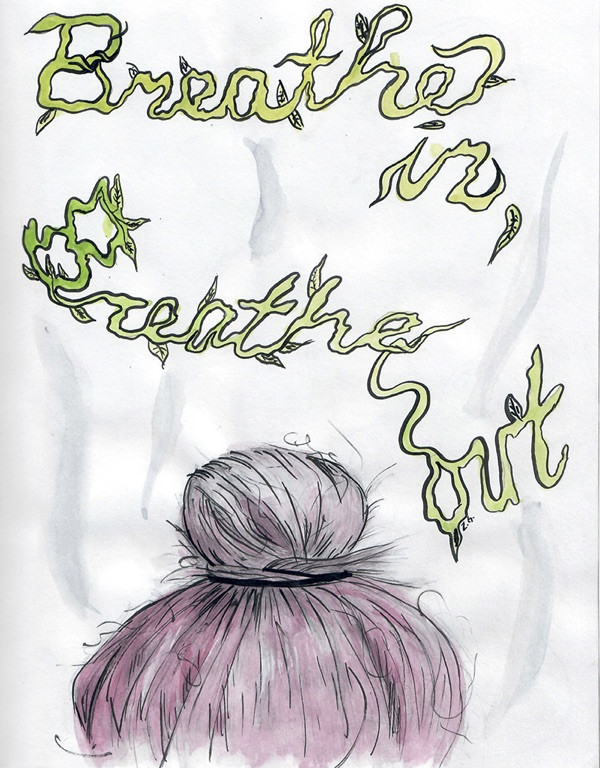Assessing Student Stress
Exploring Mindfulness as a Coping Mechanism
In the city of Uppsala, Sweden, they have this thing called the Flogsta scream. Every evening, at about 10 p.m., university students living in the neighbourhood let out raging screams from their apartment windows and into the night.
Apparently, they’re blowing off some of that good ol’ student angst.
We, as students, can relate. Sometimes bills, pressure to get good grades and the constant questioning of our futures gets to us. In 2016, the Canadian Association of College and University Student Services announced that 77 per cent of survey respondents said they might want help for a mental health problem that was seriously bothering them.
When my first anxiety attack hit, I didn’t scream through a window. I jumped in a hot bath and cried to calm my nerves. It was only when that, and my boyfriend’s soothing words, made no change whatsoever that I started to wonder if this absolute sense of dread would be unbearable. Little did I know at that moment that I’d be entering a year-and-a-half long cycle of dread where I’d experience symptoms of panic attacks, general anxiety, major depression and depersonalization disorders.
Luckily for me, through multiple therapists, discussions and experiences, I came across the practice of mindfulness. Mindfulness originates from Buddhist belief and is generally defined as being fully aware of the present moment on purpose and without judgment. Although easier said than done, all sensations, thoughts and feelings passing by must be experienced without avoidance or resistance.
Three years ago, my problem developed because everything about my life stressed me out. Now, please don’t get me wrong; stress can be one of the best things for us. It motivates us, makes us grow and gets us ready to meet new challenges. The problem appears when stress levels are too high for too long, since stress uses up our bodies adaptivity reserves. Imagine it like this: you have a blender that goes to a maximum of 1,000 rotations per minute and you decide to tweak it, crank it up to 2,000 rpm, and just leave it running. Unsurprisingly, your blender will eventually break down.
The other problem appeared when I decided, that day, crying naked in my tub, to reject any experience my negative emotions brought to me. The biggest reinforcement factor of most mental illnesses is avoidance. Fearing my most painful feelings was the one thing I wish someone told me to never do.
With mindfulness, it’s absolutely the contrary. When anxiety sweeps in, instead of reacting to it with frustration or hopelessness, you try to objectively observe the feeling and its characteristics. What bodily sensations appear? Notice how your chest feels, whether the sensation is hot or sharp, or if it spreads to other body parts. What are your thoughts telling you? Are they angry, guilty or sad? Does it hurt when they appear before you? If you apply this with curiosity and an open mind, the exploration is limitless.
So, how does all of this actually help? By purposely bringing your attention to the present moment, you actually give yourself a chance to respond thoughtfully. As psychiatrist Viktor Frankl once put it: “Between stimulus and response there’s a space. In that space lies our power to choose our response. In our response lies our growth and our freedom.”
Picture this: two papers are due, you have a job to think of and a room to clean. “I don’t have enough time, I’m overwhelmed,’’ you tell yourself. But this time, instead of believing the thought like you usually would, you take your time to actually look at it, the feeling that comes with it, and the perspective it gives you on life. Observing it this way makes you see only the belief, and perhaps not the true hardened fact, that you don’t have the time you need. It becomes posible for you to challenge that belief by trying to do all those things without any kind of stress-related procrastination. The results might surprise you.
The space you can give between you and your thought while being mindful is the same space Dr. Frankl referred to. It is a crucial amount of freedom that people who live through mental disorders can use to take a step back from their suffering and finally make more positive alternative choices.
In 2013, The Association for University and College Counseling Center Directors reported that depression and anxiety brought more people to university counselling centres than any other mental health problem by far. Both honestly made my life a living hell, but I also know that other students go through the same perhaps milder versions of what I went through.
The practice of mindfulness has always been particularly useful because you don’t need to depend on anyone but yourself to apply it. It’s always available, accessible and free. Through it, you gain more control by learning to let go of control. Obviously, not everyone will react as I did, but after my experience, I do strongly believe that all students could use a little mindfulness in their lives.


_600_832_s.png)




